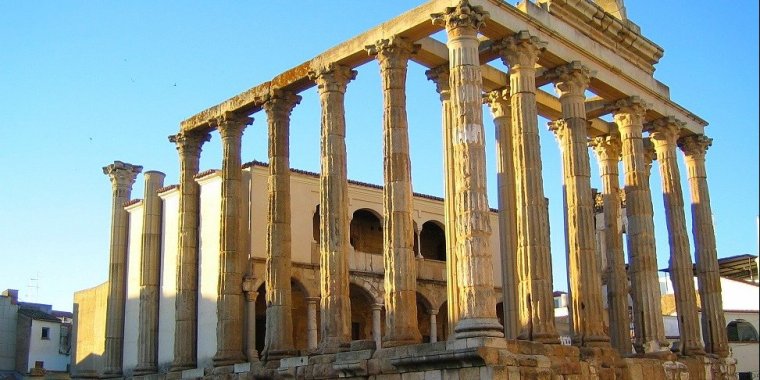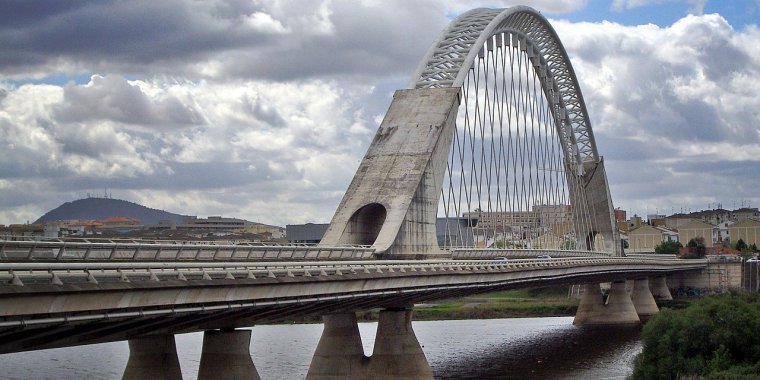| Published in Attractions / Places of Interest |
Tourist Attractions in Mérida, Spain
Roman ruins
Roman ruins in Mérida are a mixture of ticketed and free sites. At the ticket booth of any site that requires paid entry, you can purchase a combined ticket for all sites. The price is €12 and the ticket does not expire. You will also be given a map to the sites (both free and paid) around the city. Ticket sales are cash only.
• Roman Theater and Amphitheater. The star attraction of the Roman sites in Merida. The theater (used for plays) and amphitheater (used for gladiator fights and spectacles) are situated next to each other and both are excellently preserved. During the summer the theater is still used for flamenco and other shows. Ticket required.

Ancient Roman theater in Mérida. ![]()
• Casa del Mitreo. Uncovered remains of an old Roman mansion. Many original floor mosaics still visible. Ticket required.
• Roman Bridge (Puente Romano). Once the longest bridge in the Roman empire. Part original Roman construction, part restoration from the Visigoth era. Still used daily by pedestrians.
• Templo de Diana. Ruins of a large temple dedicated to the Roman empire, dating from the founding of the city. Parts of the structure were later reused in the Moorish period and after. Temple is in the city center. Free to view.
• Portico del Foro. Uncovered section of foundation of the old city Forum, with a few reconstructed columns. Free to view.
• Arch of Trajan. Large archway that was once one of principal entrances to the city. The surrounding structure has been lost but the arch itself remains standing in the midst of the modern city.
• The Alcazaba. Remains of a Moorish fortress built using material and part of the structure of the original Roman city walls. Can walk along the outer wall for a view of the river and old bridge. Ticket required.
• Circo Romano Hippodrome. The ruins of an ancient stadium where chariot races would have been held. Outside of the city center. Ticket required for entry.
• Rabo de Buey-San Lázaro Aqueduct. Across the street from the CIrco Romano, three pillars are all that remain of the structure of the Roman aqueduct. Better preserved remains from a 16th century aqueduct also stand in the same location. Open to the public.
• Acueducto de los Milagros. Large, impressive section of a Roman aqueduct (three levels high) that runs across the center of what is now a city park. Free to visit.
• Zona Arqueológica de Morería. A small, mostly derelict, section of remains of the city entrance next the river that has been uncovered. Ticket required.
• Museo Nacional de Arte Romano (National Museum of Roman Art) designed by Rafael Moneo.
• Church of Santa Eulalia, dating to the 4th century but rebuilt in the 13th century. Its portico reuses parts of an ancient temple of Mars.
Other sights
• Cathedral of Saint Mary Major (13th-14th centuries)

Cathedral of Saint Mary Major. ![]()
• Renaissance Ayuntamiento (Town Hall)
• Church of Santa Clara (17th century)
• Gothic church of Nuestra Señora de la Antigua (15th-16th centuries)
• Baroque church of Nuestra Señora del Carmen (18th century)
• The Escuela de la Administración Pública (Public Administration College)
• The Consejerías y Asamblea de Junta de Extremadura (councils and parliament of Extremadura)
• The Agencía de la Vivienda de Extremadura (Housing Agency of Extremadura)
• The Biblioteca del Estado (State Library)
• The Palacio de Congresos y Exposiciones (auditorium)
• The Factoría de Ocio y Creación Joven (cultural and leisure center for youth)
• The Complejo Cultural Hernán Cortés (cultural centre)
• The Universidad de Mérida (Mérida University)
• The Confederación Hidrografica del Guadiana (Guadiana Hydrographic Confederation designed by Rafael Moneo)
• The Lusitania Bridge over the Guadiana River designed by Santiago Calatrava
• The Palacio de Justicia (Justice Hall). (Wikivoyage, Wikipedia)
See also Mérida in Pictures.
YOU MAY ALSO LIKE





 If you own or manage a travel-related business such as a hotel, a bed-and-breakfast, a restaurant, a pub or a cafeteria, you can create a web page for your business for free on Titi Tudorancea Travel Info. » |







